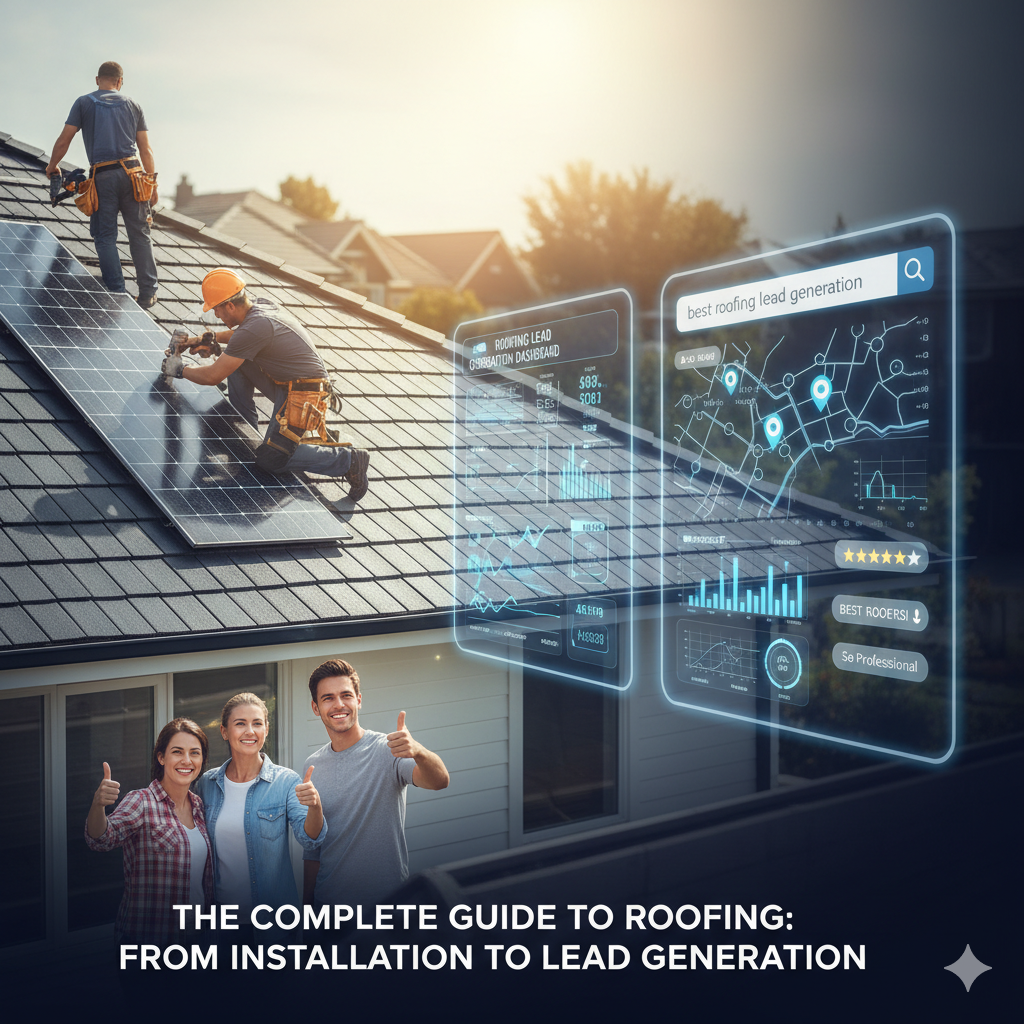The Complete Guide to Roofing: From Advantages to Lead Generation

A roof is much more than just a cover; it’s a vital component of a home’s value, efficiency, and aesthetics. It stands as the primary defense against the elements while also playing a significant role in a home’s curb appeal and energy performance. This guide serves as a comprehensive resource for both homeowners deciding on a new roof and roofing professionals looking to grow their business. We’ll explore the tangible advantages and types of roofing materials for homeowners, followed by the best roofing lead generation strategies for professionals to consistently attract new clients.
The Advantages of a Quality Roof: Why it Matters to Homeowners
Investing in a quality roof offers a range of benefits that go far beyond basic protection.
A. Protection from the Elements 🛡️
The primary function of any roof is to shield a home from the destructive forces of rain, snow, wind, and sun. A well-installed roof prevents leaks that can lead to costly water damage, rot, and the growth of mold. This foundational protection is non-negotiable for a safe and healthy living environment.
B. Energy Efficiency and Cost Savings ⚡
A new roof can dramatically improve a home’s energy efficiency. Modern materials and coatings, often referred to as “cool roofs,” are designed to reflect solar heat, significantly reducing the heat absorbed by the house. This, in turn, lessens the burden on your HVAC system, leading to lower energy bills. Properly insulated and ventilated attics, supported by a new roof, further contribute to this cost-saving effect.
C. Enhanced Curb Appeal and Property Value 🏡
A new roof instantly revitalizes a home’s appearance. With a vast variety of styles, colors, and textures available—from classic asphalt shingles to modern metal panels—a new roof can complement any architectural design. As a significant selling point, a roof replacement is a smart investment that can offer a high return on investment (ROI), making it more attractive to potential buyers.
D. Durability and Longevity 💪
The lifespan of a roof is a key consideration. Different materials offer varying levels of durability, from the common 15-20 year lifespan of a standard asphalt shingle roof to the 40-70+ years for metal or tile roofing. Selecting a material with a strong wind resistance or hail impact rating is crucial for long-term performance, especially in areas prone to severe weather.
A Look at Key Roofing Materials and Their Benefits
Choosing the right roofing material is a decision based on cost, durability, and aesthetics.
A. Asphalt Shingles
- Pros: Affordability, easy installation, and a wide variety of colors and styles make them a popular choice for most homeowners.
- Cons: They have a relatively shorter lifespan compared to other materials
B. Metal Roofing
- Pros: Known for their exceptional durability and longevity, metal roofs are also fire-resistant, energy-efficient, and require very little maintenance.
- Cons: The initial cost is higher, and they can be noisy during heavy rain or hail.
C. Tile (Clay & Concrete)
- Pros: Highly durable with a very long lifespan (50-100+ years), tile roofs offer excellent fire resistance and a unique aesthetic appeal, perfect for Mediterranean or Spanish-style homes.
- Cons: They are heavy and may require additional structural support.
D. Synthetic and Composite Materials
- Pros: These materials mimic the look of natural slate or wood shake but with improved durability, a lighter weight, and resistance to rot and insects.
- Cons: They can be more expensive than traditional asphalt shingles.
Roofing Lead Generation: Strategies for Business Growth
For roofing contractors, a consistent flow of leads is essential for survival and growth. The most successful roofing companies employ a multi-channel approach that combines digital and traditional methods to generate roofing leads.
A. Foundational Digital Marketing Strategies
- Website Optimization: Your website is your digital storefront. It must be professional, mobile-friendly, and feature clear contact information, service pages, and a portfolio of past work.
- Local SEO: This is the key to being found by homeowners in your service area. Optimizing your Google Business Profile with reviews and accurate information is crucial. You should also create location-specific content that targets searches like “roofers near me” or “roof repair [City Name].”
- Content Marketing: A blog filled with high-value content—such as articles on “how to find a good roofing contractor” or “cost of a roof replacement“—builds authority and attracts organic traffic.
B. Paid Advertising to Generate Leads Quickly
- Google Ads (PPC): Pay-Per-Click advertising is the fastest way to target high-intent leads. By bidding on keywords like “emergency roof repair,” your ads will appear at the top of search results for people who need your services immediately.
- Social Media Advertising: Platforms like Facebook and Instagram allow you to reach homeowners in your service area with demographic-specific ads, such as lead generation forms for a free roof inspection or a free estimate.
C. Traditional & Relationship-Based Lead Generation
- Referral Programs: Word-of-mouth remains the most powerful lead source. Implement a formal referral system that rewards past clients, or partner with real estate agents and home inspectors who can send you a steady stream of business.
- Community Involvement: Building a trusted brand presence through local sponsorships or events can create goodwill and attract future clients.
- Direct Outreach: For areas recently hit by a storm, door-knocking with a clear offer for a roof inspection can be a highly effective strategy.
D. Leveraging Reviews and Reputation
- The Power of Online Reviews: Positive reviews on Google, Yelp, and other platforms are vital social proof. A strong reputation builds trust with potential clients and can influence their decision more than any advertisement.
- Reputation Management: Actively manage your online reputation by professionally and promptly responding to all reviews, both positive and negative.
Conclusion: The Synergy of Quality and Strategy
A successful and sustainable roofing business is built on two core pillars. First, you must deliver a high-quality product that offers genuine, long-term advantages to the homeowner. Second, you must have a robust and consistent lead generation for roofing strategy. The best roofing contractors understand that combining a solid reputation with a multi-channel approach—from local SEO and paid ads to referrals and direct outreach—is the key to a full project pipeline and continued business growth.
